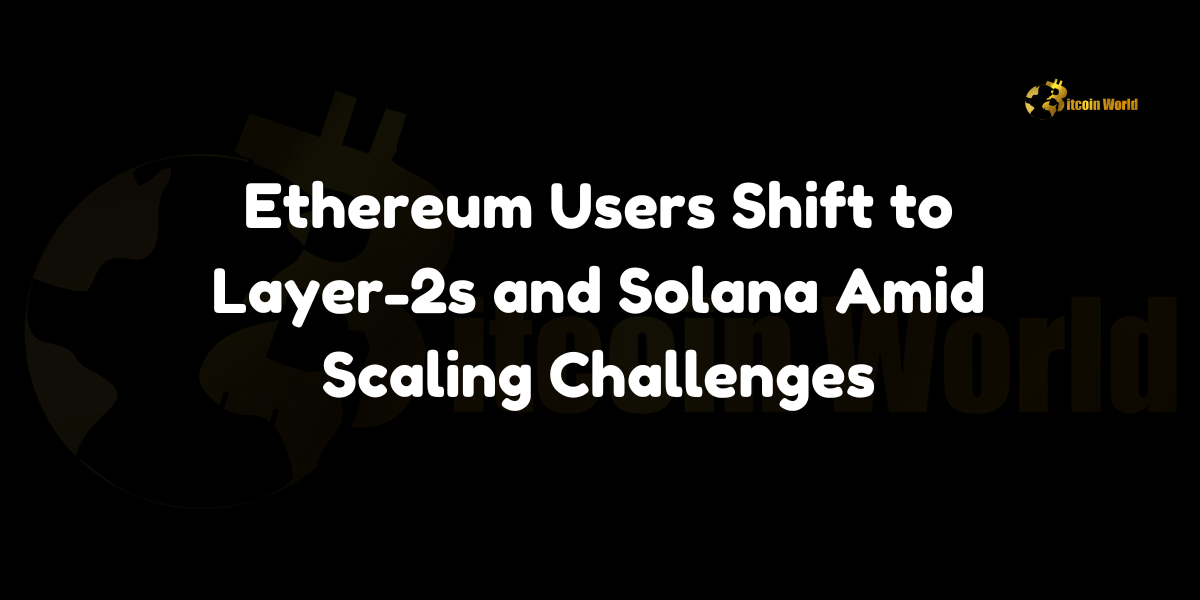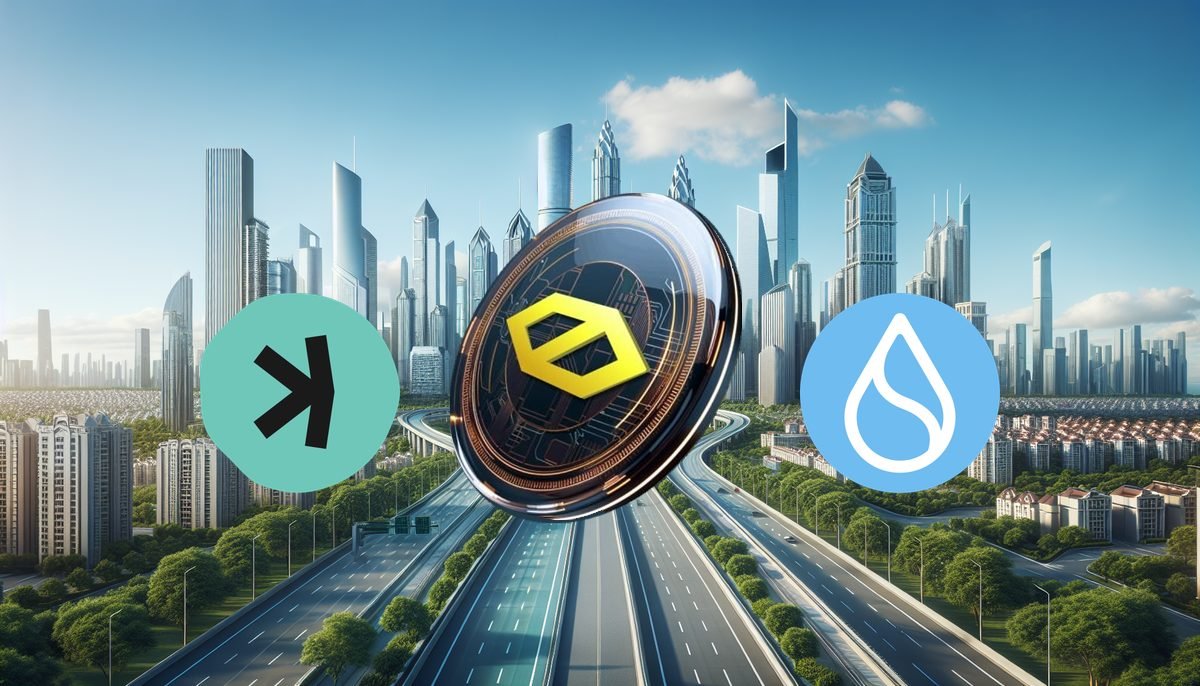Crptocurrency
Ethereum Users Shift to Layer-2s and Solana Amid Scaling Challenges

As Ethereum grapples with persistent scaling limitations, a significant migration of users and liquidity is underway towards layer-2 solutions and alternative blockchains like Solana. According to recent reports by The Block, this shift is driven by Ethereum’s mainnet constraints, prompting users to seek more efficient and scalable platforms. Analysts like Anmol Singh of Zeta Markets highlight Ethereum’s scaling challenges, while Qi Zhou of QuarkChain warns of potential liquidity fragmentation across layer-2s. In contrast, Solana’s robust architecture is attracting users with its high transaction throughput and consolidated liquidity, resulting in Solana’s active user base surpassing Ethereum’s and its total value locked (TVL) rising to $6.3 billion since June, despite declines in Ethereum’s TVL.
Introduction to the Migration Trend
Ethereum’s Scaling Constraints
Ethereum has long been the cornerstone of the decentralized finance (DeFi) ecosystem, renowned for its robust smart contract capabilities. However, the network has faced significant scaling challenges, including high gas fees and limited transaction throughput. These limitations have created bottlenecks, especially during periods of high demand, leading users to seek alternative solutions that offer greater efficiency and lower costs.
Rise of Layer-2 Solutions
Layer-2 solutions, such as Optimism, Arbitrum, and Polygon, have emerged as critical tools to address Ethereum’s scaling issues. By operating atop the Ethereum mainnet, these solutions aim to increase transaction speeds and reduce fees without compromising security. Despite their potential, analysts like Qi Zhou caution that the proliferation of isolated liquidity across multiple layer-2s could result in fragmentation, making it challenging to maintain seamless interoperability and liquidity aggregation.
Expert Insights on the Migration
Anmol Singh’s Perspective
Anmol Singh, head analyst at Zeta Markets, attributes the migration to Ethereum’s scaling constraints. He notes that the high gas fees and network congestion have become deterrents for users, pushing them towards layer-2 solutions that offer more affordable and faster transactions. Singh emphasizes that while layer-2s provide immediate relief, their long-term success hinges on achieving interoperability and liquidity consolidation to prevent ecosystem fragmentation.
Qi Zhou’s Cautionary View
Qi Zhou, CEO of QuarkChain, offers a cautionary perspective, highlighting the risks associated with liquidity fragmentation across layer-2 solutions. He warns that without a unified approach, the DeFi ecosystem could suffer from inefficiencies, reducing the overall effectiveness of decentralized applications (dApps). Zhou advocates for strategic integrations and cross-layer liquidity solutions to ensure that the benefits of layer-2s are fully realized without compromising the ecosystem’s cohesiveness.
Solana’s Competitive Edge
High Transaction Throughput
Solana has positioned itself as a formidable alternative to Ethereum by offering exceptionally high transaction throughput, capable of processing thousands of transactions per second (TPS). This capability significantly reduces transaction times and fees, making Solana an attractive option for both developers and users seeking scalability.
Consolidated Liquidity
Unlike the fragmented liquidity seen across multiple layer-2 solutions on Ethereum, Solana benefits from consolidated liquidity within its ecosystem. This consolidation enhances the efficiency and effectiveness of DeFi applications, ensuring that liquidity remains robust and readily accessible across various platforms and services.
Recent Performance Metrics
Recent data underscores Solana’s growing dominance in the blockchain space:
- Active User Base: Solana’s active user base has surpassed that of Ethereum, indicating a strong shift in user preference towards more scalable and cost-effective platforms.
- Total Value Locked (TVL): Solana’s TVL has surged to $6.3 billion since June, while Ethereum’s TVL has experienced declines, further highlighting the migration trend.
Implications for the DeFi Ecosystem
Enhanced User Experience
The migration to layer-2s and Solana offers users a more streamlined and cost-effective experience. Lower fees and faster transaction times improve the usability of DeFi applications, attracting a broader user base and fostering greater participation in decentralized financial activities.
Potential for Ecosystem Fragmentation
While layer-2 solutions provide immediate solutions to scaling issues, the lack of unified liquidity could lead to ecosystem fragmentation. This fragmentation may hinder the seamless operation of dApps and reduce the overall efficiency of the DeFi ecosystem. Ensuring interoperability and liquidity aggregation across layer-2s is crucial to maintaining a cohesive and efficient DeFi landscape.
Solana’s Role in Shaping DeFi
Solana’s robust architecture and consolidated liquidity position it as a key player in the DeFi ecosystem. By offering a scalable and efficient platform, Solana is enabling the development of more sophisticated and high-performance DeFi applications, setting new standards for what decentralized financial systems can achieve.
Future Outlook
Continued Innovation and Integration
As Ethereum continues to develop and implement scaling solutions, such as sharding and further layer-2 integrations, the competitive landscape will evolve. The success of layer-2s in addressing scaling challenges will depend on their ability to integrate seamlessly and maintain robust liquidity across the ecosystem.
Strategic Collaborations
Collaborations between layer-2 solutions and major blockchain projects like Solana could foster a more interconnected and efficient DeFi ecosystem. Strategic partnerships aimed at liquidity aggregation and interoperability will be essential in mitigating the risks of fragmentation and enhancing the overall functionality of decentralized applications.
Long-Term Viability of Solana
Solana’s continued growth and adoption will be contingent on its ability to maintain high transaction throughput, ensure network security, and support the development of innovative DeFi applications. As Solana continues to attract users and liquidity, its role as a leading DeFi platform is likely to solidify further, challenging Ethereum’s dominance in the process.
Conclusion
The migration of Ethereum users to layer-2 solutions and alternative blockchains like Solana underscores the urgent need for scalable and efficient blockchain platforms within the DeFi ecosystem. While Ethereum remains a foundational pillar, its scaling challenges are driving significant shifts towards more performant alternatives. Analysts like Anmol Singh and Qi Zhou highlight both the opportunities and risks associated with this migration, emphasizing the importance of strategic integrations and liquidity management.
Solana’s superior transaction throughput and consolidated liquidity make it a compelling choice for DeFi users and developers, as evidenced by its growing active user base and increasing TVL. However, the long-term sustainability of this trend will depend on the continued innovation and collaborative efforts within the blockchain community to address the inherent challenges of scaling and liquidity fragmentation.
As the blockchain landscape continues to evolve, the interplay between Ethereum’s scaling solutions and the rise of alternative blockchains will shape the future of decentralized finance, driving further innovation and adoption across the global financial ecosystem.
To stay updated on the latest developments in blockchain scaling solutions and DeFi trends, explore our article on latest news, where we cover significant events and their impact on the digital asset ecosystem.
Disclaimer: The information provided is not trading advice, Bitcoinworld.co.in holds no liability for any investments made based on the information provided on this page. We strongly recommend independent research and/or consultation with a qualified professional before making any investment decisions.
Crptocurrency
The Hunt for the Next Shiba Inu Ends Here! This Token Could 50x by Year-End

Crptocurrency
Ethereum Revenue Boost Expected as Layer-2 Activity Surges

Ethereum Revenue Boost Expected as Layer-2 Activity Surges
Ethereum’s network revenue is poised for a significant revival, driven by the rapid expansion of Layer-2 (L2) networks. In November 2024, L2 solutions like Base, Scroll, and World Chain tripled the transaction data posted to Ethereum’s mainnet compared to March, according to Dune Analytics. This surge in activity underscores the growing adoption of L2 technologies, which aim to increase Ethereum’s scalability and reduce costs, thereby enhancing the user experience and the blockchain’s overall ecosystem.
The boost in L2 network transactions comes at a critical time for Ethereum, as the network is recovering from the impact of the Dencun upgrade, implemented in March 2024. While the upgrade initially led to a notable drop in Ethereum’s revenue due to reduced transaction fees, the resurgence in activity through L2 networks is driving a revenue recovery. Matthew Sigel of VanEck projects that this trend could help Ethereum achieve $66 billion in annual cash flow by 2030, potentially driving the price of ETH up to $22,000. With renewed investor interest following the U.S. presidential election win of Donald Trump, which saw ETH prices rise 10%, Ethereum’s future looks promising as demand for efficient blockchain solutions continues to grow.
Understanding the Role of Layer-2 Networks in Ethereum’s Growth
Layer-2 solutions are scaling technologies built on top of Ethereum’s mainnet, enabling faster and more affordable transactions. By offloading some of the transaction load from the main Ethereum blockchain, these networks significantly reduce congestion and enhance transaction speeds. L2 networks have become a cornerstone of Ethereum’s strategy to address the scalability issues that have long hindered its growth and adoption.
The benefits of L2 networks go beyond speed and cost efficiency. They allow for more sophisticated applications to run on the blockchain, enabling use cases in decentralized finance (DeFi), gaming, and non-fungible tokens (NFTs). As the popularity of these applications increases, so does the demand for a scalable blockchain that can support high transaction volumes without compromising performance. With L2 solutions like Base, Scroll, and World Chain posting record transaction volumes, Ethereum’s scalability efforts appear to be paying off.
Ethereum’s Dencun Upgrade: A Double-Edged Sword
The Dencun upgrade, deployed in March 2024, introduced a range of improvements aimed at enhancing Ethereum’s efficiency and reducing transaction fees. However, these changes initially led to a drop in Ethereum’s network revenue, as transaction fees constitute a substantial portion of its earnings. Lower fees, while beneficial for users, resulted in a temporary revenue slump for the network.
Now, as L2 solutions drive transaction volumes back up, Ethereum is beginning to recover from this initial setback. The combined effect of lower fees and increased transaction volumes could yield a more sustainable revenue model, balancing affordability for users with profitability for the network. As L2 adoption accelerates, Ethereum’s revenue model could shift towards one that prioritizes transaction volume over fee structure, a change that would align well with the broader goals of blockchain scalability and accessibility.
Projected Revenue and Market Value: What’s Next for Ethereum?
The increased activity on Ethereum’s L2 networks has sparked renewed optimism among investors and analysts. According to VanEck’s Matthew Sigel, Ethereum’s annual cash flow could reach an impressive $66 billion by 2030. This projection assumes continued adoption of L2 solutions, as well as the sustained growth of decentralized applications (dApps) and DeFi platforms. Sigel’s analysis also indicates that this increased revenue potential could drive the price of ETH to approximately $22,000 over the next six years.
These projections reflect Ethereum’s potential to become a dominant force in the blockchain space, particularly as the network transitions to a more scalable and efficient model. For investors, Ethereum’s future revenue potential represents an opportunity to capitalize on the platform’s growth, as the blockchain continues to establish itself as the backbone of the decentralized internet.
The Impact of the U.S. Presidential Election on Ethereum and Crypto Markets
The recent U.S. presidential election, which saw Donald Trump winning a second term, has had a notable impact on the crypto market. Following the election, ETH prices surged by 10%, with Ether-based ETFs in the U.S. witnessing $52.3 million in net inflows. This trend suggests a renewed interest in cryptocurrency investments, as investors seek alternatives to traditional assets amid potential economic uncertainty.
Trump’s re-election has led to speculation around potential changes in regulatory policies that could either support or hinder the growth of the crypto industry. For Ethereum and other major cryptocurrencies, a more favorable regulatory environment could lead to increased institutional adoption, driving demand and potentially pushing prices higher. Conversely, restrictive policies could create challenges for the industry, though the resilience of blockchain technology and decentralized finance would likely persist.
The influx of investment into U.S. spot Ether ETFs highlights a shift in investor sentiment, with many viewing cryptocurrencies as a viable long-term asset class. This renewed interest in Ethereum and the broader crypto market signals a growing recognition of digital assets as an integral part of modern finance.
Challenges and Opportunities Ahead for Ethereum
While the outlook for Ethereum appears promising, several challenges remain. Scalability, security, and regulatory concerns continue to pose risks to the network’s growth. Although L2 solutions offer a temporary fix for scalability, further upgrades and innovations will be needed to sustain long-term growth. The Ethereum community is actively working on future updates to address these issues, including the anticipated “Shard Chains” upgrade, which aims to further enhance Ethereum’s scalability by splitting the blockchain into multiple “shards” that can process transactions in parallel.
In addition to technical challenges, Ethereum faces increasing competition from other blockchain networks that offer similar functionality with potentially greater scalability or lower fees. Projects like Solana, Polkadot, and Cardano are rapidly evolving and could pose a threat to Ethereum’s dominance in the smart contract and dApp ecosystem. However, Ethereum’s first-mover advantage, combined with its active developer community and widespread adoption, provides it with a strong foundation to maintain its position in the market.
Conclusion
Ethereum’s projected revenue growth, driven by the surge in Layer-2 network activity, paints an optimistic picture for the blockchain’s future. As L2 networks like Base, Scroll, and World Chain drive up transaction volumes, Ethereum is beginning to recover from the revenue slump experienced post-Dencun upgrade. With projections of $66 billion in annual cash flow by 2030 and a potential ETH price of $22,000, Ethereum is positioning itself as a key player in the evolving digital economy.
The recent spike in ETH prices following the U.S. presidential election and the inflow of funds into Ether ETFs underscore the growing interest in crypto assets as viable investments. However, Ethereum must navigate several challenges, including scalability and competition, to maintain its growth trajectory. As the Ethereum network continues to evolve and adapt to the demands of a rapidly changing landscape, it has the potential to redefine the future of decentralized finance and the broader blockchain industry.
To learn more about the innovative startups shaping the future of the crypto industry, explore our article on the latest news, where we delve into the most promising ventures and their potential to disrupt traditional industries.
Crptocurrency
Invest $500 in These High-Growth Altcoins and Secure a $2 Million Crypto Portfolio by 2025

-

 Startup Stories1 year ago
Startup Stories1 year agoWhy Millennials, GenZs Are Riding The Investment Tech Wave In India
-

 Startup Stories1 year ago
Startup Stories1 year agoStartups That Caught Our Eyes In September 2023
-

 Startup Stories1 year ago
Startup Stories1 year agoHow Raaho Is Using Tech To Transform India’s Fragmented Commercial Trucking
-

 Startup Stories1 year ago
Startup Stories1 year agoMeet The 10 Indian Startup Gems In The Indian Jewellery Industry’s Crown
-

 Crptocurrency8 months ago
Crptocurrency8 months agoLither is Making Crypto Safe, Fun, and Profitable for Everyone!
-

 Startup Stories1 year ago
Startup Stories1 year agoHow Volt Money Is Unlocking The Value Of Mutual Funds With Secured Lending
-

 E-commerce1 year ago
E-commerce1 year agoTop Online Couponing Trends To Watch Out For In 2016
-

 Startup Stories1 year ago
Startup Stories1 year agoWhy Moscow-Based Kladana Considers Indian SME Sector As The Next Big Market For Cloud Computing




